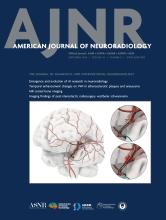This article requires a subscription to view the full text. If you have a subscription you may use the login form below to view the article. Access to this article can also be purchased.
ASNR members
Login to the site using your ASNR member credentials
Log in using your username and password
Log in through your institution
You may be able to gain access using your login credentials for your institution. Contact your library if you do not have a username and password.












